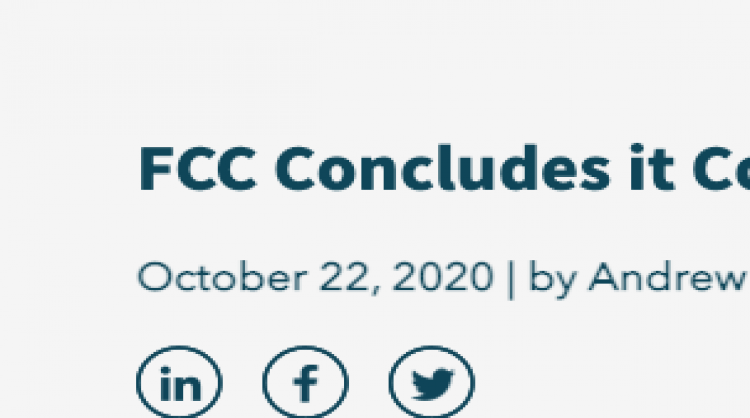FCC Concludes it Correctly Decided Net Neutrality Order
October 22, 2020 | by Andrew Regitsky

One year ago, the D.C. Circuit Court determined that the FCC’s Restoring Internet Freedom Order (Order) largely passed muster. The Court found that the Commission’s decision to treat broadband Internet access service (BIAS) as a Title I information service was lawful which enabled the FCC to eliminate the Net Neutrality requirements of no blocking, throttling, or paid prioritization of Internet traffic.
The DC Circuit did remand certain parts of the FCC Order back to the agency for further explanations. These include (1) the Commission’s failure to explain the effects of its rules on public safety, (2) the fact that the information classification took broadband outside the statutory rules for pole attachments, and (3) the new classification removes broadband from inclusion in the Lifeline program. None on these issues forced the Court to vacate any section of the Order.
A year later, at its upcoming October 27, 2020 meeting, the Commission is expected to adopt an Order on Remand (Remand Order) in Docket 17-108 in which it is expected to conclude that for each defect identified by the Court, there is no basis to alter its original conclusions in the Restoring Internet Freedom Order. In a Fact Sheet released on October 6, 2020, the Commission states that its decisions in the Order improve public safety:
The light-touch regulatory approach it adopted and the regulatory certainty it provided in the Restoring Internet Freedom Order benefits public safety and furthers its charge of promoting “safety of life and property” and the national defense though the use of wire and radio communications.
Neither its decision to return broadband Internet access service to its longstanding classification as an information service, nor its decision to eliminate the Internet conduct rules, is likely to adversely impact public safety. The Internet conduct rules would have required Internet service providers (ISPs) to gain Commission approval before introducing new and potentially innovative services.
The agency bases its conclusion on the fact that there are many ways for public service agencies to communicate with each other and the public that were unaffected by the Order. For example, the Commission points to the First Responder Network that Congress created in 2012. This is a nationwide, interoperable public safety network dedicated to “ensure the deployment and operation of a nationwide, broadband network for public safety communications.” It is a resilient network capable of supporting both data and voice communications.
The Commission dismisses examples in which the absence of Internet rules may have adversely impacted public safety. For example, it argues that the case in which the Santa Clara fire department had its broadband service throttled because it reached its data cap was a customer service error rather than caused by classifying broadband Internet access as an information service.
Next, regarding pole attachments, the Commission argues that the benefits of returning to the light-touch information service classification far outweigh the limited potential negative effects resulting from the loss of section 224 pole attachment rights for broadband-only ISPs. ISPs which provide only broadband service are a small minority these days (less than 10 percent of all ISPs). Moreover, these companies are free to negotiate pole attachment contracts with the facility owners.
Finally, the Commission finds it has legal authority under section 254(e) of the Communications Act to provide Lifeline support to eligible telecommunications carriers that provide broadband service over broadband-capable networks that are also used for voice service. Section 254(e) states that Eligible Telephone Companies (ETCs) “shall be eligible to receive specific Federal universal service support” and that an ETC receiving universal service support “shall use that support only for the provision, maintenance, and upgrading of facilities and services for which the support is intended.” Based on this provision, the Commission concludes it has the authority to include broadband as a supported Lifeline service.
Consumer groups have reacted with horror to the Commission’s decision to defend its Restoring Internet Freedom Order. They should not have been surprised. Did they honestly believe this anti-regulation FCC would restore broadband Internet access service as a Title II telecommunications service? Consumer advocates are free to appeal this Order on Remand back to the D.C. Circuit, but it is hard to see how the Court could find the Commission’s arguments here arbitrary and capricious.
Of course, things could change if Joe Biden wins the election. With three Democrats running the FCC we could be back to square one on Internet regulation. This is squarely because Congress continues to fail to update the Telecommunications Act to recognize how the Internet now dominates. Really, they are pathetic!

